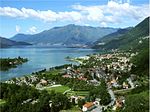Tempietto di San Fedelino sul Lago Mezzola
11th-century Roman Catholic church buildings in ItalyChurches in the province of SondrioItalian church stubsRomanesque architecture in Lombardy
The Tempietto di San Fedelino', also known as the Oratorio di San Fedele, is a 10th to 11th-century small, Roman Catholic sanctuary or church, located in a remote rural site Via San Fedelino near Novate Mezzola, at the south shore of the River Mera where it feeds Lake Mezzola, province of Sondrio, region of Lombardy, Italy. The small church is made of local stone and has a rounded apse. It still retains some 11th-century frescoes. The frescoes resemble those from the apse of the church of San Vincenzo in Galliano (circa 1004–1007).46°12′53″N 9°26′23″E
Excerpt from the Wikipedia article Tempietto di San Fedelino sul Lago Mezzola (License: CC BY-SA 3.0, Authors).Tempietto di San Fedelino sul Lago Mezzola
Via Giumello, Samolaco
Geographical coordinates (GPS) Address Phone number External links Nearby Places Show on map
Geographical coordinates (GPS)
| Latitude | Longitude |
|---|---|
| N 46.214722222222 ° | E 9.4397222222222 ° |
Address
Oratorio di San Fedele (Tempietto di San Fedelino)
Via Giumello
23027 Samolaco
Lombardy, Italy
Open on Google Maps






